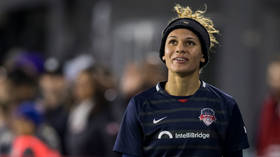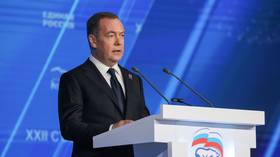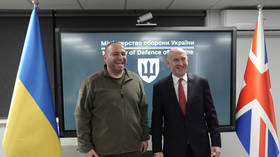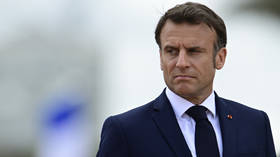US women’s soccer stars win $24 million equal pay battle
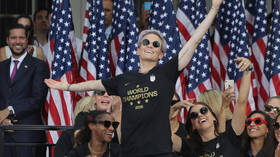
A group of 28 US women's national team (USWNT) players settled a class action equal pay lawsuit against the US Soccer Federation (USSF) for $24 million in total, as confirmed by a court filing.
The players will first receive a lump sum payment of $22 million from the USSF paid out in a way that is approved by the District Court after being proposed by the USWNT stars.
Later, the USSF will hand over an additional $2 million to aid USWNT players in achieving their post-career goals, and charity efforts related to women's and girls' soccer in the US with each player able to apply for funding of up to $50,000 from the sum.
U.S. Soccer and @USWNT are proudly standing together in a shared commitment to advancing equality in soccer. pic.twitter.com/Sp8q7NY0Up
— U.S. Soccer (@ussoccer) February 22, 2022
Speaking to ESPN, USWNT star midfielder Megan Rapinoe claimed: "There's no real justice in this other than this never happening again.
"With the settlement of the working conditions and this settlement which is contingent upon a CBA [Collective Bargaining Agreement] that will have equal pay going forward, there's no other way to look at it than just a monumental win for women's sports and women's soccer, in particular," Rapinoe added.
Once the CBA has been ratified by the USWNT players, the District Court's final approval of the settlement will be scheduled which, according to a statement from the players, "will fully resolve the litigation".
Reacting to the news, the USWNTPA women's player's union called the settlement "an important step in righting the many wrongs of the past."
"The USWNTPA congratulates the players and their litigation team on their historic success in fighting decades of discrimination perpetuated by the US Soccer Federation. Although the settlement reached today is an incredible success, much work remains to be done," the union said in a statement.
The USWNT players originally sought a much bigger fee of $66.7 million in back pay when filing the lawsuit for "institutionalized gender discrimination" focusing on the two main areas of equal pay and working conditions. Even so, the lower settlement amount is regarded as a victory for the women who have long championed equal pay in sports alongside fans who chanted "Equal pay" during the USWNT's 2-0 World Cup final win over the Netherlands in 2019.
At one point, in May 2020, the equal pay part of their lawsuit was dismissed which forced the players to appeal last July stressing that US District Court Judge Gary Klausner erred by not looking at pay rates and the fact that women needed to win more often than their male counterparts to receive bonuses. Yet in the end, they managed to land a significant amount of money with Rapinoe revealing she was sure of victory.
"I'm not a big fan of roller coasters, in real life or figuratively," the OL Reign star said. "I did think we would get to this point, 100%. I did think we would win all along in this. This is a win for us. And this is a win for the players for the next generation, for women's players around the world."
Though the USSF has taken a hit to its reputation and pocket from the lawsuit, the settlement, which was achieved before a scheduled March 7 hearing, still represents a promise that was kept by its president Cindy Parlow Cone.
"I said it many times before, that resolving the litigation was a top priority for me. I think I said it on day three of my presidency, and I continue to feel that way," Cone explained to ESPN. "I continue to be optimistic that we are going to get this done and like Megan says, I think this is a win for US soccer, [and] so [a] win for women's team sports, and women in general."
"I think what made the final push across the line was just getting the players together," Cone claimed. "And just communicating with me and a couple of my board members with the players and trying to see where the sticking points were and how we can move forward. I think everyone wants to move forward so that we can shift the focus from this litigation."
Another bump in the road came in March 2020, when the USSF received backlash for claiming in a legal filing that the USWNT players "do not perform equal work requiring equal skill [and] effort" as "the overall soccer-playing ability required to compete at the senior men's national team level is materially influenced by the level of certain physical attributes such as speed and strength."
This caused then-president Carlos Cordeiro to resign and be replaced by Cone, and the two are now running for the USSF's top position in a leadership election in under a fortnight.
As the men's and women's players belong to different unions, they had different pay models in their separate CBAs. While the men played under a pay-to-play model for the national team if they were called up to form part of the national team's squad, they also earned extra cash for actually playing in US men's national team games.
On the other hand, the women are signed to full-time contracts paying 16 current players a fixed salary of $100,000 per year whether they play in a game, are only called up to the squad, or are injured.
As benefits include parental leave, other athletes are referred to as "non-contract players" and are only paid when called up to the USWNT. But the main sticking point for the women's players were bonus structures in each sex's contracts.
If a men's player makes a World Cup squad, he currently makes a $67,000 bonus while a woman for the record four-time winners of the competition makes just $37,000.
Then, if the USMNT wins against a team ranked outside FIFA's top 25, a male player is paid $9,375 while receiving $5,000 for a loss. For the women, a win against a team outside the top eight pays just $5,250 and nothing at all for a loss.
If the men's team win an unlikely World Cup title, each player will be paid $407,608 while the much-better performing women make just $110,000.
The USSF argued that the women's contracts were bargained collectively, and that players preferred a guaranteed salary while it also has no control over FIFA bonuses for winning the World Cup and would see the Federation bankrupted if agreeing to the amounts the women sought.
The women claimed that the bonus structure alone highlighted they were being discriminated against, but Cone remained optimistic that extra work on the case relating to the CBAs can be completed by the end of next month.
"We have a lot of work to do and continuing to rebuild the relationship with the players," Cone conceded. "We have to come to a solution on the CBA agreements. But the focus now shifts to growing the game from a commercial perspective with our strategic partners, and having the players on our side to go hand in hand and to encourage Fifa to equalize the World Cup prize money."
Simultaneously, Rapinoe is prepared to take her group's equal pay fight to world governing body FIFA if needs be.
"I think for a long time that [World Cup bonus] inequity was just sort of willingly passed along to us," Rapinoe complained. "I think both parties agree now that that's not the right way to go about it. And so both of us can go lockstep and go at FIFA for how unfair, not just the prize money [is], but [also] the resources and the investment and the care and effort and everything put towards the women's game.
"I'm looking forward to being a part of that change moving forward," Rapinoe finished.
Additionally, USSF has also made a commitment to providing equal rates of pay for the women's and men's US national teams "in all friendlies and tournaments, including the World Cup".
Nearer to the end of this year, the men's World Cup will be held in Qatar while the USWNT defend their women's World Cup crown in Australia and New Zealand in 2023.

